
Graphics
If we were going to describe the graphics in Velvet Assassin then we’d say ‘efficient’ and then we’d be out of a job because we can’t hit required wordcounts. Damn. Forget we said that.The graphics in Velvet Assassin are nothing extraordinary though, to put it plainly. We played the game with all three of the graphics options (Texture Detail, Shadow Quality and Shader Quality) set to high and while the game looked good, it didn’t exactly set our eyeballs on fire. In fact, the only way to get that effect is to go to Tim’s house for his home-cooked curry...
Still, even with some of the settings on lower levels we still didn’t think the game looked bad, though you can judge for yourselves by checking out the screenshots we’ve included on this page to show how the game might look on your system. If anything, the game looked good – the details were as crisp as fried potatoes, the bloom like fresh roses and the motion blur appropriately sickening...but still, this isn’t exactly Crysis, is it?
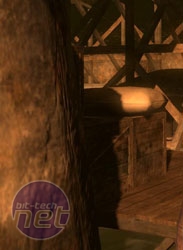
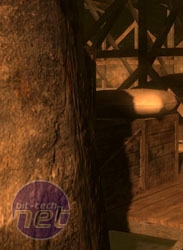
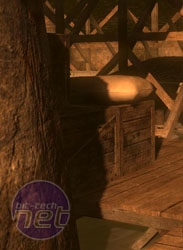
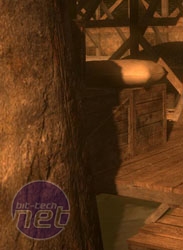
Texture Detail in Velvet Assassin on Low, Medium, High and Very High (left to right), click to enlarge
The highlight of Velvet Assassin’s graphical system though is, unsurprisingly, the lighting system. Since the major focus of the gameplay is on evasion rather than confrontation you’ll do an awful lot of shadow-skulking in any given level, but the lighting system also extends beyond this a little. As well as hiding in shadows and stalking your prey you can also create shadow and temporary hiding places in a number of ways.
Sometimes the system is as simple as breaking an obviously-placed fusebox and then back-stabbing the guard who comes to repair the fault. Other times you might want to waste valuable ammo (why, oh, why does Violette only carry one ammo clip?) by shooting out the lights. These are two standard methods for creating shadows in game and both have been old since long before Garrett introduced players to water-arrows in Thief.
Velvet Assassin manages to take things one step further though by encouraging players to use the dynamic shadows to their advantage. Why waste a bullet on a lightbulb or risk attracting guards when a more effortless solution would be to just push a box in front of the spotlight? Admittedly, it’s not something that’s going to change the face of gaming, but having an extra option for killing Nazis is always a good thing, right?
Of course that's right. That’s why the game gives you the option to stab enemies or just pull the pins out of their grenades if you can sneak up behind them, or why you can electrocute them in pools of water. Or gas them. Or shoot them. Burn them. Strangle them. Explode them.
Velvet Assassin isn’t, as all you 3DFX GPU-users will probably be pleased to hear, not a particularly demanding game when it comes to hardware either. The recommended requirements for the game, listing only 1GB of RAM, a 3GHz CPU and a 256MB graphics card (GeForce 6800 or better), which should easily be within reach of most gamer's systems.
Bear in mind that that configuration will only get you the lowest settings though, so if you’re only just hitting that mark then it’s best to check out the screenshots above to decide whether or not you think they’re acceptable.
Performance-wise, we had absolutely no problems running the game on our current gaming system, which packs an overclocked X6800 CPU, 3.25GB of accessible memory and an Nvidia GeForce GTX 280, all of which run the latest drivers. The game itself is on Steam, so patching shouldn’t really be a worry.

MSI MPG Velox 100R Chassis Review
October 14 2021 | 15:04


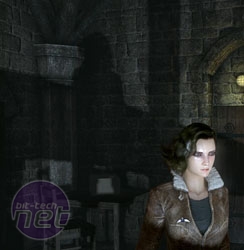









Want to comment? Please log in.